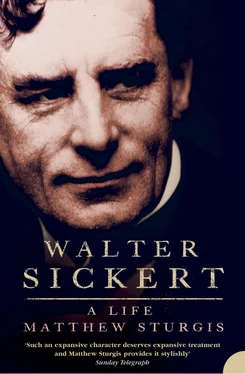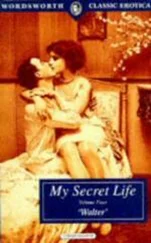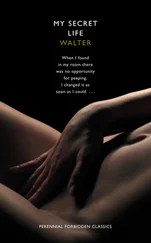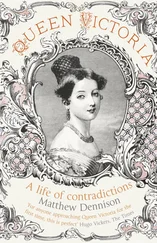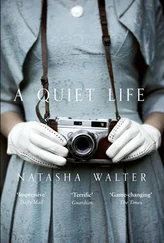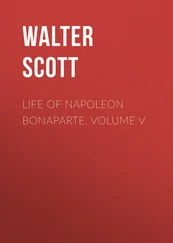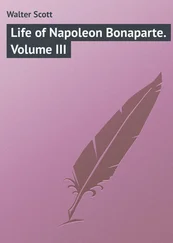The master of masters is Irving, and his lofty roof-trees stand
In glory of gold and marble, by the river’s golden Strand.
They are high, well-built and glorious, and many doors have they,
But one door is low-browed and mystic and dim and cloudy and grey,
And over its darkling throat, on the very lintel is writ
In letters of fire of magic, the name of the Mouth of the Pit.…
A goodly company are they of damsels and lofty men
And ten are high-born maidens, and fearless knights are ten.
And there on the steps of the threshold they range in a two fold ring,
Round a radiant lady, their leader, whose name is a month in spring.
The ‘radiant lady’ reference was to Margery May, a Slade scholar (and the future Lady Horne), who was the most impassioned devotee. Amongst the listed assembly of ‘fearless knights’ Sickert was designated as ‘a scholar, well-taught in many a thing,/Who journeyed north to join them, from the College of the King’. 33 By this band, Irving was accounted a deity. When the Sickerts’ down-to-earth cook poured cold water on their ‘Irving delirium’ by remarking, ‘After all, Irving’s only a man when all’s said and done’, it came – Walter recalled – ‘as a shock to Margery May, and certainly to me’. 34
In imitation of Irving, Sickert began mounting his own Shakespearean productions in the holidays. He named his troupe the Hypocrites, or ‘Hyps’. During the summer of 1877, while staying at Newquay, he dragooned his siblings and friends into performing a cut-down version of Macbeth . It was a radical open-air production staged in an old quarry. The dramatic effect of the setting, however, was slightly undermined when Walter (in the title role) turned his ankle while making his first entrance down the steep scree – and completed the descent upon his bottom, to the ill-suppressed amusement of the three witches. 35 It was not the sort of thing that happened to Irving – and Irving was Walter’s model. He developed an arresting impersonation of the great man’s style. At the school prize day that Christmas he caused what the headmaster described as a ‘sensation’ with his rendition of a speech from Richard III in the manner of Irving. 36 It was a performance that raised Sickert to a new prominence within the school, eclipsing even his coincidental triumph in the Vice-Master’s German Prize. *
Sickert’s friendship with the Slade rabble-rousers forged an important connection in his mind between art and the theatre. Years later he recalled the benefits of this nexus, and urged the ‘stage’ to draw, once more, closer to the ‘brush’. (He suggested that the Old Vic and Sadler’s Wells should offer free seats in the gallery to all art students.) ‘Actors’, as he noted, ‘know there is no propaganda like the enthusiasm of young students’; while the stage offered young painters not only an education in English literature but also a potential subject. Even as a teenager, it seems, Sickert recognized the possibility of making pictures ‘drawn from the theatre’. 37
In the short term, his friendship with the band of stage-struck art students served to open up the London art world for him, bringing him into contact with the more vital currents of contemporary painting. Inspired, as he later admitted, in part by ‘intellectual snobbishness’ and ‘the “urge” to compete in agreeing with ladies a little older’ than himself, he began to look beyond the simple pleasures of ‘the narrative picture’ and to fidget after ‘novelty’. 38
Artistic novelty was in rather short supply in the London of the late 1870s. The great masters of the previous age, Constable and Turner, were dead, and their heirs were not apparent. The Royal Academy had become stultified by its own commercial success, and had dragged most of the other chartered art institutions along with it. The founders of the Pre-Raphaelite Brotherhood – who had promised to reinvigorate art in the 1850s – had gone their separate ways. Rossetti had retreated into seclusion, and no longer exhibited. Holman Hunt stood aloof. Millais had embraced the world, acceding to the Royal Academy, social success, and a highly profitable career as a portrait painter. He was the self-assumed ‘head of the profession’, and he held that the baronetcy he had received was no more than a proper ‘encouragement to the pursuit of art in its highest and noblest form’. He lived in a mansion in Palace Gate, and Sickert would sometimes see him sitting with a friend on a bench in Kensington Gardens, ‘a touching and majestical presence’, resembling more ‘an angelic and blustering personification of John Bull’ than a painter. 39 The vast majority of British artists subscribed only too gladly – as one critic has said – to John Wilkie’s ‘cynical formula that “to know the taste of the public, to learn what will best please the employer, is to the artist the most valuable of knowledge”’. And what the paying public wanted was anecdote, sentiment, moral tone, and workmanship. To a society that saw virtue in labour, ‘high finish’ was regarded as the one necessary technical requirement. The other – even more important – criterion was subject matter: it had to be either sentimental or edifying, and – if possible – both. The Baby was the dominant motif of most British exhibitions at this period. 40
And yet within the tradition there were some signs of flickering life. George Frederick Watts, though he claimed that his pictures ‘were not paintings but sermons’, was producing works of undeniable force and achievement. There was vitality, too, in both the idealized classicism of Frederic Leighton, Lawrence Alma-Tadema, Edward Poynter, and Albert Moore, and the romanticized realism of a second generation of Pre-Raphaelites – the heirs of Rossetti – led by Edward Burne-Jones and William Morris.
Arthur Kennedy took Sickert and other Slade friends to Burne-Jones’s house in the North End Road, West Kensington. There they were allowed to look over the artist’s studio and inspect his pictures of gracefully androgynous beings with retroussé noses looking pale and interesting amongst garlands of improbably detailed flora. Sickert was impressed, but grudgingly so. He recognized Burne-Jones as a ‘brilliant draughtsman’ but remained only half-attracted – and half repelled – by his paintings. The realm of ‘strange and exquisite fancy’ that the artist had created, though undeniably powerful, was impossibly alien to Sickert, who possessed almost no sense of ‘fancy’, exquisite or otherwise. 41 Nevertheless, despite his artistic reservations he found himself connected – albeit loosely – to this ardent Pre-Raphaelite world. His sister, Helena, now fourteen, was attending Notting Hill High School and had become friendly both with Burne-Jones’s daughter, Margaret, and William Morris’s two girls, Jenny and Mary (known as ‘Jennyanmay’). They often spent their weekends at each other’s houses; Helena would borrow copies of Morris’s beautifully produced Kelmscott books and bring them home. Both Morris and Burne-Jones called on the Sickerts, while Morris’s disciple, William de Morgan, was already known to the family through his connection with the Sheepshanks. 42
Sickert encountered Burne-Jones’s work again later in that summer of 1877 at the inaugural exhibition of the Grosvenor Gallery in Bond Street. It was the art event of the year. The Grosvenor was a new phenomenon. There had been commercial galleries before, but none conceived on such a scale, nor carried off with such taste. Established by Sir Coutts Lindsay and his wife, it was to be a veritable ‘Temple of Art’, offering the discerning public the chance to see the most up-to-date work in surroundings that suggested an idealized drawing room, or ‘some old Venetian palace’, rather than an overcrowded auction house. 43 Burne-Jones was the star of the show, represented by, amongst other major works, The Seven Days of Creation, The Mirror of Venus , and The Beguiling of Merlin . There were pictures by his followers and rivals, minutely detailed, richly coloured representations of myth and legend. One wall glowed with the brooding metaphorical figure-paintings of G. F. Watts, another with the serene, soft-tinted classical beauties of Albert Moore. But it was not these that excited the 17-year-old Sickert. His attention was arrested by three tall canvases hung to the left of the door in the ‘large gallery’. All were interesting, and one was particularly well calculated to appeal: a portrait of Henry Irving as Phillip II of Spain. They were the work of the American-born, Paris-trained artist, James McNeill Whistler.
Читать дальше
